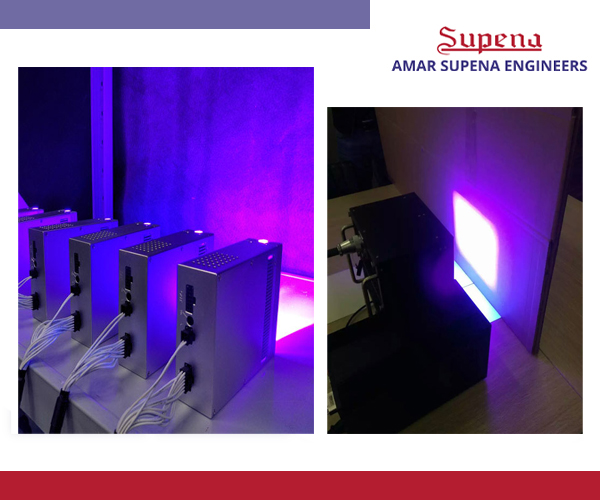
UV LED Curing for Digital Printing | Revolutionizing the Printing Industry with High Efficiency and Sustainability
Digital printing has seen significant advancements over the years, with innovations designed to improve the quality, speed, and environmental impact of printing processes. One such game-changing technology is UV LED curing. This method has rapidly become the go-to solution for high-quality digital printing, offering unmatched benefits like faster curing, reduced energy consumption, and enhanced sustainability. In this blog, we will explore the growing importance of UV LED curing systems in digital printing, how they work, their advantages, and why Amar Supena Engineers is a trusted name in providing cutting-edge UV LED curing systems for the digital printing industry.
What is UV LED Curing?
UV LED curing refers to the use of ultraviolet light emitted by LEDs (light-emitting diodes) to cure or harden inks, coatings, and adhesives used in the digital printing process. This curing method utilizes UV light at specific wavelengths (typically in the UV-A spectrum) to trigger a photochemical reaction that instantly dries and hardens the printed material. Unlike traditional curing methods that use mercury vapor lamps, UV LED curing systems use solid-state LED technology, which has revolutionized the printing industry in terms of efficiency, cost-effectiveness, and environmental sustainability.
In digital printing, UV LED curing is commonly used with UV inks that are formulated to dry when exposed to UV light. This enables faster production times and more reliable results, making UV LED curing an ideal choice for both high-quality and high-speed digital printing applications.
How Does UV LED Curing Work in Digital Printing?
The operation of a UV LED curing in digital printing is quite simple yet highly effective. The key components of a UV LED curing system include:
1. UV LED Light Source: This is the heart of the system, consisting of high-performance LEDs that emit ultraviolet light. The specific wavelengths (typically ranging from 365 nm to 405 nm) are chosen to match the photoinitiators in the ink, allowing for instant curing.
2. UV Ink: UV inks are specially formulated to cure when exposed to UV light. These inks are available in a variety of formulations, including those for printing on paper, plastics, glass, and even metals. UV LED curing systems activate the photoinitiators in these inks, leading to the hardening process.
3. Reflectors and Lenses: The UV light emitted by the LEDs is often reflected and focused onto the printed material through reflectors and lenses. This ensures that the print is evenly cured, providing consistent results.
4. Cooling System: Though LED lights generate much less heat than traditional UV lamps, they still require cooling to ensure optimal performance and long operational life. Efficient cooling systems are incorporated to maintain the LEDs at the correct operating temperature.
5. Power Supply: The power supply provides the necessary energy to the LEDs, ensuring a consistent and stable curing process throughout the print run.
6. Control System: Modern UV LED curing systems often come with advanced control systems that allow operators to adjust curing parameters like intensity, speed, and time, providing greater flexibility and precision.
Advantages of UV LED Curing in Digital Printing
The adoption of UV LED curing technology in digital printing offers a host of benefits, making it an attractive choice for modern printing businesses. Letâs take a look at the key advantages:
1. Faster Curing and Increased Productivity
One of the standout benefits of UV LED curing in digital printing is its speed. UV inks cure almost instantly when exposed to UV light, allowing prints to be handled immediately after printing. This dramatically reduces drying times, allowing for faster job turnaround and higher production speeds. Faster curing helps prevent bottlenecks in the printing process and boosts overall productivity, which is particularly advantageous in high-demand industries like packaging, promotional materials, and large-format printing.
2. Energy Efficiency and Cost Savings
UV LED curing systems are highly energy-efficient compared to traditional UV mercury lamps. LED lights consume significantly less power and produce far less heat, reducing the need for complex and costly cooling systems. As a result, businesses can experience lower energy bills while still achieving high-performance curing results. The long lifespan of LED lightsâup to 20,000 to 25,000 hoursâalso reduces the frequency of lamp replacements, which further reduces maintenance costs.
Since UV LEDs are energy-efficient and only require power when curing is needed, businesses can see significant cost savings over time. This makes UV LED curing an ideal solution for companies aiming to lower operational costs and increase profitability.
3. Environmental Sustainability
With increasing global concern about environmental issues, UV LED curing offers a highly sustainable alternative to traditional curing methods. UV LEDs contain no mercury, unlike traditional mercury vapor lamps, which pose health and environmental risks if not disposed of properly. Additionally, UV LED systems do not produce ozone, which is a key concern in some industrial settings.
The low energy consumption of UV LED curing systems also means reduced greenhouse gas emissions, making them a more eco-friendly option for businesses looking to reduce their carbon footprint. By switching to UV LED technology, companies can align their operations with environmentally responsible practices and contribute to a greener future.
4. Improved Print Quality and Durability
UV LED curing results in superior print quality compared to traditional drying methods. The instant curing of UV inks allows for sharper, more precise images and vibrant colors. This is particularly beneficial for high-end applications such as packaging, labels, and promotional printing, where visual appeal and consistency are essential.
Moreover, UV-cured prints exhibit greater resistance to scratching, fading, and other forms of damage, which improves the durability of the final product. For products that require long-lasting finishes, such as outdoor signage or product labels, UV LED curing ensures that the print remains intact and vibrant for longer periods, even in harsh environments.
5. Ability to Print on a Wide Range of Substrates
One of the main advantages of UV LED curing in digital printing is its versatility. UV-cured inks adhere well to a wide range of substrates, including paper, plastic, metal, glass, and even non-porous materials like acrylic and vinyl. This opens up opportunities for businesses to expand their product offerings and explore new markets.
Whether itâs printing on rigid materials for packaging or printing on flexible substrates for promotional materials, UV LED curing technology ensures consistent results across various surfaces, providing businesses with greater flexibility in their product offerings.
6. Reduced Heat Sensitivity
UV LED curing generates minimal heat, making it ideal for printing on heat-sensitive materials. Traditional UV lamps can generate excessive heat, which can warp or distort sensitive substrates, particularly thin films and plastics. UV LED systems, on the other hand, are gentle enough to print on delicate materials without the risk of damage.
This makes UV LED curing ideal for a range of applications, including flexible packaging, electronics printing, and promotional materials where heat-sensitive materials are used.
Applications of UV LED Curing in Digital Printing
UV LED curing is versatile and has found applications in many areas of digital printing. Some of the most common applications include:
1. Packaging and Label Printing
UV LED curing has revolutionized the packaging and label printing industries by offering faster drying times and higher-quality finishes. UV LED printers can print on a wide variety of substrates, including films, plastics, and metallic materials, making it possible to produce durable, high-quality labels and packaging materials at faster speeds.
2. Large Format Printing
In large-format printing, such as banners, posters, and signage, UV LED curing is highly effective for producing vibrant and long-lasting prints. The instant curing allows for quick handling of large prints, reducing production time and increasing overall throughput.
3. Industrial and Promotional Printing
Promotional products such as custom printed items, including t-shirts, mugs, and pens, benefit from UV LED curingâs speed and quality. Since UV-cured prints are highly durable and resistant to wear, they are ideal for products that require a long-lasting design.
4. Textile Printing
UV LED curing has also been successfully applied in textile printing, offering high-quality prints with excellent durability. The ability to print on both rigid and flexible materials makes UV LED curing a preferred choice for textile manufacturers looking to produce vibrant and long-lasting designs.
Why Choose Amar Supena Engineers for UV LED Curing Systems?
Amar Supena Engineers is a trusted provider of UV LED curing systems, known for their cutting-edge technology, reliability, and commitment to customer satisfaction. Hereâs why businesses choose Amar Supena Engineers for their digital printing needs:
1. Industry Expertise
With years of experience in the UV curing industry, Amar Supena Engineers provides advanced UV LED curing systems that are designed to meet the specific needs of the digital printing market. Their systems are engineered for performance, efficiency, and longevity.
2. Customized Solutions
Every business has unique requirements, and Amar Supena Engineers understands that. They offer customizable UV LED curing solutions that can be tailored to suit a wide range of digital printing applications, ensuring optimal performance for every project.
3. Energy Efficiency and Sustainability
Amar Supena Engineers is committed to helping businesses reduce their environmental impact. Their UV LED curing systems are highly energy-efficient, lowering operational costs and minimizing carbon footprints.
4. Customer Support and Service
When you choose Amar Supena Engineers, you get more than just a productâyou get a partnership. Their team provides comprehensive support, from system installation to ongoing maintenance, ensuring that your UV LED curing systems run smoothly and efficiently.
Conclusion
UV LED curing technology is revolutionizing the digital printing industry, offering faster curing times, improved print quality, and enhanced sustainability. As businesses strive for greater efficiency and environmental responsibility, UV LED curing has emerged as the solution of choice for a wide range of printing applications. With Amar Supena Engineers at the forefront of this innovation


